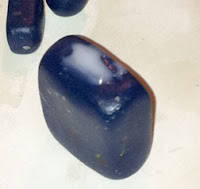Every year for Valentines day I make my kids a special piece of jewelry. They are still little and I know this will get lost, but in time they may come to value that mom made them something special. Or not.
This year they seem to be full of squees when it comes to cute little square robots.
I was totally inspired by a wire artist I follow on facebook, who had a give away day for her tutorials as a big "Thank you" to all of her followers. So I wanted to give you all a free tutorial. Since I only have two tuts over on clay lessons, I decided to just publish the freebee here.
So happy Valentine's Day if you celebrate it, if not, happy February 14th! heres a little robot tutorial for you!
Supplies/ tools
half block polymer clay
big pinch of pink or red polymer clay for a heart
liquid polymer clay
eye pin (or twist your own with 2" wire)
2 seed beads
1 bugle bead
ball tip burnishing tool, or aluminum knitting needle
oven roaster bag
dedicated pie pan
index card
cookie sheet
Component building
Condition and start forming the pieces of your robot. I hand formed my body parts, you may decide for a more mechanical look to use a tissue blade to cut out your boxes.
 All of my sizes are "ish" meaning not exactly
All of my sizes are "ish" meaning not exactlyyou will need:
3 small balls for "rivets"= 1/8 inch round
1 top knot = 1/8' tall x 3/16 x 3/16
1 head = 3/8" x 3/8" 1/8 thick
1 body = 1/2" x 1/2" 1/4" thick
1 hip box = 1/4" x 1/2" 1/4 thick
2 legs = cubes 1/4" per side
2 feet = balls 1/4" round
2 arms = 1/8"x 3/16" 1/8" thick
2 wrists = medium balls 3/16" round
2 hand pads = rounded triangles about 3/8" long
from the second color of clay a heart a little larger than the hand paddles.
Again the sizes are not exact, and you may find that you like a wider body and no hip box.
Assemble the body
 Use a bit of liquid polymer between the pieces to ensure they cure together.
Use a bit of liquid polymer between the pieces to ensure they cure together.Attach the top knot to the top of the head, then add the head to the body.
At this point add the eye pin: make an indent with your ball burnisher (or knitting needle tip), add some liquid polymer clay into the divot, then shove the eye pin in.
Continue to build the robot body, remember to add a drop of liquid polymer between pieces.
Add the face
Using the ball burnisher or knitting needle make two small divots for the eyes, fill the divots with a small drop of liquid clay, place the seed beads so the hole looks like a pupil. Push the bead into the clay with the burnisher.
For the mouth make three small divots for the bugle bead, repeat the process you did with the eyes: a drop of liquid clay, place the bead, push into the clay.



Assemble the arms
There are two arm styles presented here.
Style A-arm along side the body: add the arms and wrist balls along side the body block.
Style B- arm holding heart: its easier to build the arm, then attach it to the body. Arm block, wrist ball, paddle hand. Make divots in the end of the arms to seat the wrist ball into. Make divots in the wrist ball to seat the paddle hands into. Place the arms so they are rotated away from the side.


Rivets
 Cut one of the small balls in half. Place on either side of the head. Using the burnisher tool or knitting needle push little divots in the middle of the ball.
Cut one of the small balls in half. Place on either side of the head. Using the burnisher tool or knitting needle push little divots in the middle of the ball.Place the remaining balls at the top of the arms (where the shoulder would rotate). Using the burnisher tool or knitting needle push little divots in the middle of the ball.
Hearts
 Style A has the heart placed in the middle of the body box, use liquid clay to help it to stick.
Style A has the heart placed in the middle of the body box, use liquid clay to help it to stick.Style B holding the heart-- now this can get tricky-- to help support the hands hold the heart, roll up a small bit of paper towel and place it on the body block. Then gently rotate the wrist balls and paddle hands in towards each other, and place the heart between the paddles. Don't use too much liquid clay here or the heart will slip out of the hands, you need just enough for the heart to stick to the hands.
Cure it
Place your robot on an index card on your dedicated pie pan. Place the pie pan in the oven roaster bag, close the roaster bag with a twist tie. Place this on the cookie sheet and cure following your clay brand instructions.
Let the robots cool completely before taking them out of the pan, the arms on robot B need to be fully cured and cooled before touching them or they may fall apart.



No comments:
Post a Comment